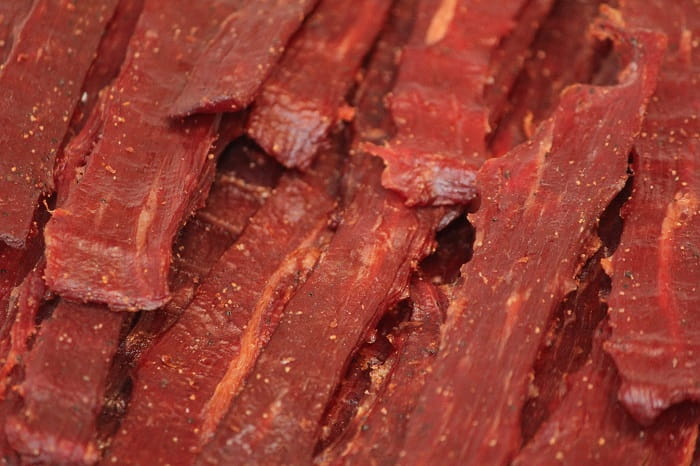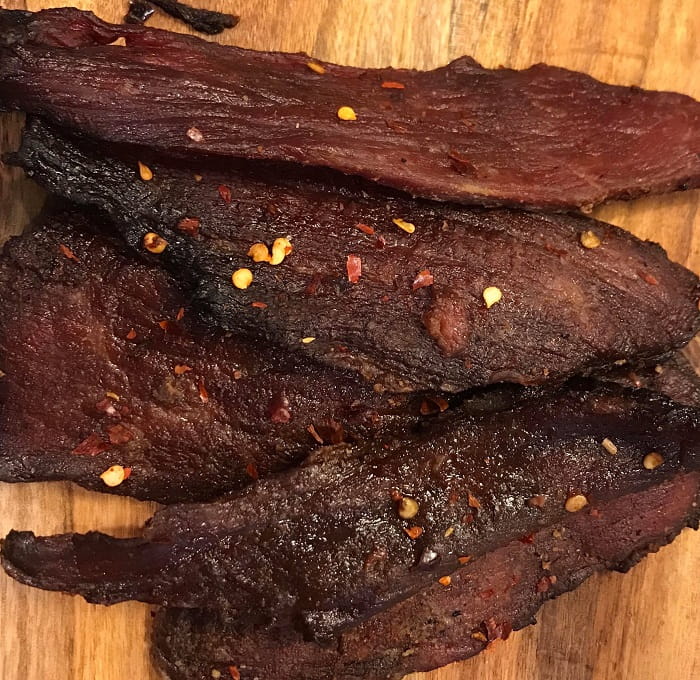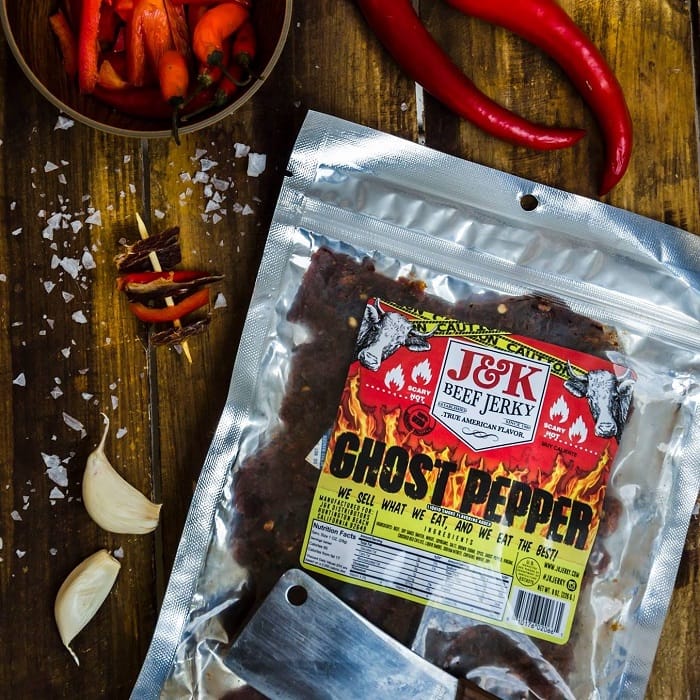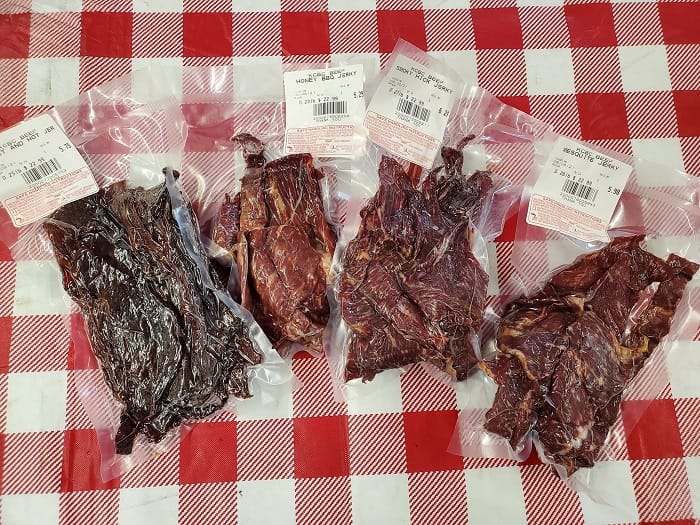You’re not alone if you’ve ever wondered why beef jerky costs so much. This delicious snack isn’t cheap, and its cost is often astronomical compared to other snacks. The most important factor in beef jerky’s price is high-quality beef. That’s why it costs so much – and you should buy the best quality you can afford.
Why Is Beef Jerky So Expensive? Let’s take a closer look.
What is beef jerky?

When buying beef jerky, pay attention to the label. You’ll want to avoid jerky that contains preservatives, as they’ve been linked to certain types of cancer. Also, be sure to find grass-fed, organic meat, if possible, which contains more nutrients and has fewer fillers and antibiotics. You should also be aware that jerky usually contains a lot of salt, which is a necessary part of the curing process.
Many jerky brands contain a high protein level, which can help you stay healthy. Wide jerky varieties also contain phosphorus, which is essential for healthy bones, healthy muscles, and proper energy production in the body. Phosphorus is also important for producing DNA and RNA, red blood cells, and bone marrow.
Beef jerky is a popular snack all over the world and comes in a variety of flavors. It can be easily packed and transported and is the perfect on-the-go snack! Although many people think it’s a processed product, it’s a healthy snack option and can last for months without spoiling.
How much is beef jerky?

Regarding beef jerky, several factors determine how much it costs. For starters, beef is an expensive protein. A traditional cut of beef can cost $5 per pound or more. The conventional process involves cutting the meat into thin strips 1/4 to 3/8 inches thick and putting them in a vacuum tumbler along with seasonings and water. The process increases the processing time, which adds to the overall cost.
Another factor determining beef jerky prices is how close the manufacturer is to the raw material. Small batch manufacturers are usually more expensive than large companies because they can’t take advantage of economies of scale. Small batch manufacturers must price their meat high enough to break even. Luckily, many companies make beef jerky from Top Round cuts, which cost only 31 cents per ounce. This means that the cost of a single pound of beef is about 7x as much as beef jerky.
Beef jerky is sold at convenience stores across the country. It makes up a large percentage of convenience store sales, and the industry makes billions of dollars per year. According to the National Beef Council, beef jerky sales topped $1 billion in 2017 and over 1.3 billion in 2015.
Why Is Beef Jerky So Expensive?
Raw Beef Cost
The raw beef jerky cost depends on several factors. It depends on the production facility’s location and the meat source. Some companies operate near the source of the beef, while others must ship the meat across the country. In such cases, the raw beef jerky cost will be higher than if the meat was produced close to the source. Moreover, the price of beef jerky will also include shipping costs.
The cost of beef jerky depends on the quantity of meat used in the production process. It requires more than 2.7 ounces of meat to produce a pound of jerky, so it will cost you more than a pound of beef. Also, it will cost you more than two pounds.
The cut of beef used in the production process affects the cost of raw beef jerky. The cut of beef used for traditional jerky is the striploin, the most tender cut. The cost of raw beef jerky will also depend on the quality of the ingredients. For instance, cheap beef jerky contains fewer spices. On the other hand, expensive beef jerky can be made from high-quality beef cuts.
High-Quality Ingredients
When looking for beef jerky, you’ll want to ensure it’s made from high-quality ingredients. You want a snack that’s low in sodium and sugar and high in protein. If you’re using a preservative, you want to avoid the kind containing MSG, a common additive in many food products. In addition, you want your snack to have a natural flavor derived from the meat’s richness, not artificial seasonings.
Quality control is extremely important in any food processing facility, and beef jerky is no exception. Meats should pass strict checks for pH, moisture content, and odor before using them for jerky. Quality control is so important that government regulations require that meat meet certain minimum standards. As a result, most jerky manufacturers use high-quality meat.
When choosing beef jerky, you’ll want to choose a brand that uses lean beef. Lean beef is the best kind for jerky, as it keeps its flavor longer. Beef with excessive fat is not recommended for jerky because of its high water content, which makes it more likely to spoil and contain undesirable additives.
Non-Automated Processing
While beef jerky is a common snack, it is often expensive due to the labor involved in its production. The beef used in jerky production is typical of higher quality than other meats. Additionally, the process of making jerky does not use fully automated equipment. It requires a lot of energy, time, and skilled labor, all factors in the price.
Making beef jerky is labor intensive, requiring high-quality ingredients and tools. In addition, the time and energy needed to dehydrate the beef results in a product with a high price. Raw beef is also expensive and cannot be sourced cheaply.
The cost of beef jerky is also influenced by where the meat comes from. The best jerky is made from beef that is lean and fat-free. This is because beef with too much fat reduces the product’s shelf life and makes it more likely to spoil. Ideally, beef jerky is 97% fat-free, which means that it requires premium cuts of beef.
Water Weight
To measure the water content of beef jerky, researchers used a method that involves heat treatment to disintegrate the protein. The meat was ground and then placed in 50 mL tubes heated in a water bath for two hours. After cooling, the solution was filtered using Whatman No. 1 filter paper. It was then diluted with distilled water to 100 mL.
The amount of water in beef jerky depends on the type of beef and its cut. Leaner cuts contain more protein and less fat, increasing water weight. Because of this, the jerky made from leaner cuts will lose more water during dehydration.
While beef jerky is incredibly popular, it has its disadvantages, too. This type of meat is expensive due to its nutritional value. It can contain up to 15% of your daily recommended saturated fat. While it’s important to follow the recommended amounts of saturated fat in your diet, beef jerky has a low saturated fat content, which makes it a healthy snack for people on a budget.
Labor-Intensive
Beef jerky is made from whole muscle cuts of beef that are trimmed and cut into thin strips. The strips of beef are then marinated in a combination of spices and salt. The marinated beef strips are then dried in a dehydrator or smoker.
The drying process can take anywhere from a few hours to a few days, depending on the size and thickness of the beef strips. The dried beef strips are then packaged and sold.
The high cost of beef jerky is due to the time and effort required to produce it. The process of making beef jerky is very labor-intensive, and the final product is a delicious and nutritious snack.
Additives

Beef jerky costs a lot to make. The raw material is expensive, and many companies add preservatives and fillers to reduce costs. However, quality beef jerky will be free of additives and likely be much more expensive than cheaper brands. The high cost of beef jerky is that it requires a premium cut of beef.
Making beef jerky requires extensive processing, including a slow, labor-intensive process. The meat shrinks by 60 to 70% during the process. In addition to the labor-intensive process, beef jerky requires USDA-approved storage space. It can take a couple of days to complete the process. Then, the beef jerky must be dried and preserved to prevent bacteria.
While raw beef is relatively inexpensive, adding other ingredients and labor costs can raise the price of beef jerky. Another factor that makes beef jerky so expensive is its amount of sodium. Despite its high cost, beef jerky is a healthy and tasty snack that does not contain harmful additives. It is an excellent alternative to other snack foods that have no nutritional value.
High Packaging Costs

The high packaging costs of beef jerky are not the only problem. The beef jerky producers must ensure that their product is inspected, displayed, and advertised. They must also implement quality control practices, some of which are paid for by the federal government. The costs involved in these processes are considerable, especially for small producers. Fortunately, there are ways to minimize these expenses. Here are some ideas to lower your production costs.
The manufacturing process of beef jerky is labor-intensive and requires specialized workers. It also has high shipping costs, which drive up consumer prices. This is not to mention the fact that it is expensive to rent a production facility. Beef jerky manufacturers have to pay the rent for this facility and pay the staff members who will process the product.
The high packaging costs of beef jerky are partly due to its low quality. While some brands produce cheaper brands, the majority of these are made from lower-quality beef and filled with unhealthy preservatives and additives. This often results in an inferior-tasting product. As a result, it’s important to buy high-quality beef jerky to ensure the quality and freshness of the snack.
Shipping Costs
Shipping costs are a significant part of the cost of beef jerky production. Raw materials must be transported from their sources to the factory, and the finished product must be delivered to retail locations. Gas is expensive, so beef jerky manufacturers must factor this expense into their business plans. Additionally, transporting raw meat from one end of the country to the other can be expensive.
Shipping costs of beef jerky vary based on the product’s weight and how far it is being shipped. Generally, orders over $100 will be shipped within three to five business days. Orders under $100 are not eligible for free shipping but will incur a shipping cost based on the weight of the products and the size of the box used for shipment.
The beef that goes into traditional beef jerky costs about $5 per pound. This amount is high because beef is a high-cost protein, and jerky production requires large amounts of raw material. In addition, beef prices fluctuate significantly. Round cuts of beef cost about $4.50 a pound, so shipping costs will vary greatly.
Although beef jerky has a long shelf life, it must be delivered quickly. For this reason, it’s essential to package the jerky properly and ship it via the United States Postal Service or a similar service. The best way to do this is to use USPS Priority Mail Express. Then, make sure it is sealed tightly. A vacuum sealer is an excellent option for creating a completely airtight seal. Additionally, a resealable zip-close plastic bag is a good idea.
Government Regulations
Starting your own beef jerky business can be an exciting and lucrative opportunity. However, it can also be a challenging one. It requires you to meet legal regulations and obtain proper guidance. The competition in the beef jerky market is intense. You will need to work hard to be successful.
Why does beef jerky cost so much for so little?
Beef jerky is a delicious treat, but it is also costly. Even if you buy it at the gas station, you’re likely to pay ten dollars or more for a bag. And what’s worse, you’ll get tiny in the bag. Still, the taste and addictiveness of beef jerky are hard to resist.
Several factors contribute to the cost of beef jerky. It’s made from raw beef and has a high sodium content. It’s also made by dehydrating it. It’s a great snack and is packed with nutrients. While beef jerky is expensive, it’s worth every penny.
Beef jerky manufacturers also need to cover the cost of transport. Raw meat has to be transported to the factory, and finished goods must be shipped to retail locations. It takes a lot of gas to get raw meat from the farm to the factory. But refrigerated semi-trucks can drive hundreds of miles to get the raw meat to its final destination.
See more:
Is jerky healthier than meat?
Beef jerky contains various nutrients, from iron to vitamin C, zinc, and phosphorus. Iron can boost your immunity and regulate your body’s temperature, while vitamin C increases red blood cells and promotes skin health. The latter two nutrients also reduce the risk of acne and high blood pressure. It also contains a good dose of folate and is an excellent source of calcium.
When choosing jerky, look for those that contain low amounts of sugar and sodium. While you don’t want to be overly deficient in protein or sodium, you don’t want to go with products that contain high amounts of sugar and MSG. Also, look for those free of artificial flavors.
When selecting a brand of beef jerky, check its labels carefully. Several manufacturers have recently been forced to recall their products due to Salmonella bacteria. Salmonella causes one million cases of foodborne illness every year. Raw beef is not immune to this bacteria, so it’s best to cook it before consuming it. The USDA recommends a minimum cooking temperature of 160 degrees Fahrenheit.
What is cowboy jerky?
Jerky is a snack made from dried meat. Traditionally, it was made in the open air with salt, smoke, and spices. In addition, Native Americans also used berries to flavor the meat, creating a type of jerky similar to pemmican. During long treks, cowboys needed to eat food that would not spoil. A jerky is a great option, as it contains high-quality meat and will keep for months without refrigeration.
Traditional beef jerky is made from meat scraps or the side of a cow. It is challenging and chewy and is traditionally chewed on with hard bread. It is best to choose lean cuts of meat to make beef jerky. Avoid using a water pan when smoking jerky, as the water will add moisture to the jerky.
Despite its popularity, beef jerky is not the healthiest snack on the market. It is high in sodium, and a single ounce contains about 22% of the recommended daily allowance. Sodium has been linked to heart disease and stroke, and consuming too much of it can raise your blood pressure.
Is beef jerky healthy to eat?
Jerky is a snack that contains a high amount of iron, vitamin A, calcium, phosphorus, and folate. Iron boosts your immunity, while vitamin A helps improve your skin and reduce acne. It is also a good source of zinc.
While jerky may not be as appealing to a health-conscious eater as some people think, it is a tasty snack with a high protein level and important vitamins and minerals. The high protein and low sugar content make this snack a great option for snacking. However, some beef jerky brands contain unhealthy ingredients and processes that may detract from their health benefits. Be sure to avoid brands with high levels of sodium and nitrates.
The American Heart Association recommends eating a diet low in sodium for overall health. While beef jerky offers a high source of lean protein, it is also high in sodium. A single ounce can contain almost 20% of an adult’s recommended daily sodium limit. Excess sodium can increase water retention, cause puffiness and bloating, and lead to various health problems.
How long is beef jerky still good?
Beef jerky can last up to two months if stored properly. This means keeping it in a cool, dry place, away from sunlight.
You can also extend the shelf life of beef jerky by vacuum sealing it. This will keep it fresh for up to six months.
However, it’s important to note that beef jerky will slowly lose its flavor the longer it’s stored. So, eating it within the first few weeks of storage is best if you’re looking for the best flavor.
How to Tell if Beef Jerky is Bad?
The best way to tell if beef jerky is terrible is to look at it. If it’s dried out or looks discolored, it’s probably not good to eat.
You can also smell the beef jerky to see if it’s gone wrong. If it smells off or like it’s spoiled, it’s best to throw it away.
If you’re unsure if the beef jerky is still good, it’s always best to err on caution and throw it away.
How to Store Beef Jerky?

To extend the shelf life of beef jerky, it’s important to store it properly.
As mentioned above, beef jerky should be stored in a cool, dry place, away from sunlight. If you’re storing it for more than a few weeks, it’s best to vacuum seal it.
You can also freeze beef jerky to extend its shelf life. However, it’s important to note that frozen beef jerky will have a different texture, so it’s best to eat it within a few months.
No matter how you like to eat your beef jerky, it’s essential to know how to store it properly to extend its shelf life. Following the tips above, you can enjoy beef jerky for up to two months.
FAQs
Is it cheaper to make beef jerky than to buy it?
Jerky is a delicious and healthy snack that can be made at home with little effort. It is also much, much cheaper than buying store-bought jerky. Making your beef jerky is a great way to save money and have a healthier snack. Store-bought jerky can contain unhealthy preservatives and additives, but making your own allows you to control what goes into it. You can also tailor the flavor to your preferences.
How much money would you need to spend to purchase a pound?
The answer to this question depends on a few factors, including the type of beef jerky, the brand, and the retailer. There are three main categories of prices: cheap, average, and expensive.
Low prices for beef jerky typically fall at $25.00 per 16 ounces and under. If you’re looking for a bargain, this is probably the price range you’ll want to focus on.
Average prices for jerky beef fall in the $25.01 – $35.00 per 16-ounce range. This is a pretty typical price range for most brands of beef jerky.
If you’re willing to spend a bit more money, beef jerky options also fall in the expensive category, typically costing $35.01 per 16 ounces and up.
Can I eat beef jerky every day?
The short answer is yes, you can eat beef jerky every day. However, like with most things in life, it’s best consumed in moderation.
Beef jerky is a high-protein, low-fat snack that makes a great addition to any diet. It’s also relatively low in calories, making it an excellent option for those watching their weight.
Is it possible to slim down by consuming jerky?
The simple answer is yes, as long as you consume jerky in moderation.
Jerky is a great protein source, essential for weight loss. A high protein diet helps to burn fat and build muscle. And, since muscle burns more calories than fat, it’s a great way to lose weight.
In addition, jerky is a low-calorie food. A 3-ounce serving of jerky has about 100 calories, making it a great snack for those watching their weight.
Can Muslims eat the beef?
The answer to this question depends on how the beef jerky was made. If the beef used to make the jerky was slaughtered according to Islamic law, then the beef jerky is halal, and Muslims can eat it. However, if the beef was not slaughtered by Islamic law, then the beef jerky is not halal, and Muslims cannot eat it.
Conclusion
The price of beef jerky can be an important consideration when deciding where to buy it. Retailers want to make a profit. Therefore, they buy a particular product at a certain price and sell it for another fee. They study the market and determine a price that will support the demand for the product. Then, they mark up the product by a certain percentage to cover their expenses. This can be as high as 300%. However, it is worth noting that supermarkets have huge costs, including labor, logistics, spoiled food, insurance, and more. This is why consumers should try to buy beef jerky in bulk from the producer.
Beef jerky stores can invest in advertising and creating displays for their product. All of this costs money and contributes to the price of beef jerky. In addition to this, the government charges taxes on a variety of products, including beef jerky. These taxes help fund important services for the country.
- How Long To Smoke Ribs At 250? - November 8, 2022
- Why Is Beef Jerky So Expensive? - September 26, 2022
- What Animal Is Steak? - September 25, 2022
